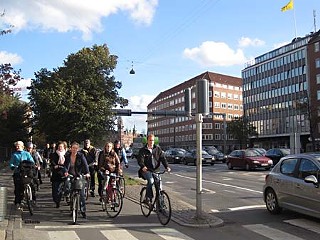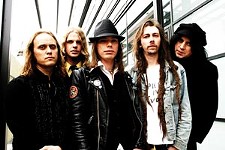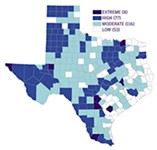Cool Cities: Dispatches From Copenhagen
Climate change, clean energy ... and bicycles
By Katherine Gregor, Fri., Oct. 16, 2009
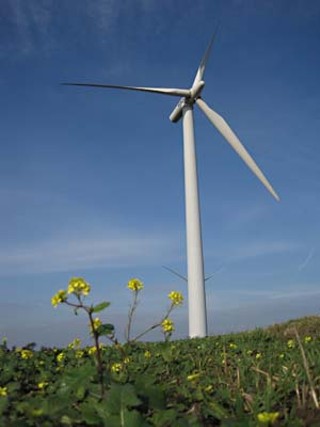
Chronicle staffer Katherine Gregor has been blogging from Copenhagen, where she's reporting on the city's climate initiatives as it prepares to host the Dec. 7-18 United Nations Climate Change Conference (aka COP15). Gregor is one of five U.S. reporters invited by the Royal Danish Embassy on the study trip. What follows are brief excerpts from her reports on the Newsdesk blog; for much more, see "Learning From Copenhagen," at austinchronicle.com/newsdesk.
Climate Consortium Denmark
Monday, Oct. 5, 1:25pmGiven Austin's aspirations to market itself as a "Clean Energy Capital" for economic development, it would do well to follow the example of Denmark. This morning, Finn Mortensen, executive director of Climate Consortium Denmark, told us how and why the public-private "cleantech" consortium was organized. ... When Copenhagen was named host city for COP15, Denmark saw a golden opportunity to promote its own clean/green companies and solutions worldwide. ... Mortensen emphasized the importance for developing countries of Denmark's positive example: Steady economic growth can go hand in hand with energy-use reduction. Denmark's gross domestic product has increased by 75% since the early 1970s, when the shift began here. ... Yet Danish energy consumption has remained constant – and shifted to 20% wind power.
"The Climate Change Conference in Copenhagen in December 2009 is an obvious opportunity to show the world that in Denmark we have reduced CO² emissions and stabilized our energy consumption while at the same time creating economic growth," explained Lene Espersen, Denmark's minister for economic and business affairs. ...
So in pursuing green jobs for Austin, the chamber of commerce, city departments and council, and the Pecan Street Project (our local public-private consortium) might take note of how it's being done in Denmark. Climate Consortium Denmark was established in February 2008 to strengthen international "awareness of the competences and solutions of Danish businesses, industries and universities in the cleantech area." ... The partners include: the Confederation of Danish Industry, the Danish Construction Association, the Danish Energy Association, the Danish Agriculture & Food Council, and the Danish Wind Industry Association, plus the Marketing Denmark Fund and the Danish state. Together the five business groups represent nearly all national commercial interests in play. Tasked with infrastructure and supply-and-demand issues is Energinet; Pecan Street Project folks should check it out at www.energinet.dk. ...
The national goal here now is to become completely free of fossil fuel use by 2050, running 50% on homegrown wind power. A how-to report and road map are due from the Danish Commission on Climate Change Policy by the end of 2010. Its work also will reflect the European Union 2050 goal for developed countries to collectively reduce their emissions of greenhouse gases by 60% to 80%. ...
Renewable Energy Island
Wednesday, Oct. 7, 8:55am`Tuesday we visited the island of Samsø, a small-scale example for the world of how to achieve carbon neutrality. Samsø – a small, bucolic island located between the Baltic and the North seas – was selected in 1997 to become a case study for renewable energy. The community of about 4,000 people has achieved its goal of becoming self-sufficient in renewable energy by executing a professional plan provided by PlanEnergit.
Samsø offers a charming, picturesque example of what whole nations might try to achieve, but on an intimate scale that's easy to comprehend. It's a pastoral place of historic thatched cottages and classic agricultural buildings, grazing livestock, rolling fields of crops (flowering rapeseed/canola, trees bright with red berries, and pumpkins this time of year), and constant views of the sea. Silhouetted against both blue sky and blue sea are its 21 wind turbines.
Our group of five American enviro-journalists took a long minibus trip to the coast, then a two-hour ferry ride out to the island. Offshore, we saw the 10 enormous, elegantly sculptural wind turbines in the south sea of Samsø. Those deliver clean electricity to the mainland grid; that's considered more than an offset for all of the gasoline and nonrenewable heating used here, including that used by the three ferries serving the island. The islanders' own energy needs are met 100% by 11 land-installed wind turbines. A power-share agreement with the mainland ensures that the island can "borrow" electricity on days when the wind doesn't blow sufficiently; it returns equal electricity as a payback on windy days.
The towns are connected to district/community heating systems that provide both hot water and heating for about 75% of the island's 2,500 pretty, traditional older homes. (There's no industry or business to speak of.) There's a solar farm that provides heating and a biomass furnace that burns woodchips from Brattingsborg Woods. We visited one of the three straw-fed community biomass heating plants that serve the villages; the straw burned is an agricultural byproduct that used to be burned in the fields. ... Some individual homeowners have also installed solar panels, geothermal heating, or wood-pellet furnaces to replace their old oil-fired boilers. ...
Great attention was paid to giving residents a sense of ownership – literally and figuratively. ... Some 450 Samsø residents now own profitable cooperative shares in the turbines (which were 100% financed by banks). ... As soon as the technology becomes available, Samsø also plans to convert to electric or other alternatively fueled vehicles. But even now, factoring in the offsets from the wind energy it sends to the mainland, Samsø is 100% carbon-neutral. ...
Everyone Here Cycles!
Wednesday, Oct. 7, 12:38pmAfter a few days in Copenhagen, I'm a convert: I've seen for myself that people in a wealthy nation can happily use the bicycle as their primary way to get around. "The never-ending flow of Copenhageners on bicycles is like a symphony of human power. ... The morning rush hour is graced with such poetic motion," is how a deliciously literate city brochure puts it. That's how it felt, too, cycling around Copenhagen with our guides, becoming part of the great flow of cyclists all over the city. Pedaling alongside such a tremendous volume of cyclists is unlike anything I've ever experienced. It transforms urban cycling into something that feels quite mainstream, social, exhilarating, and fun. ...
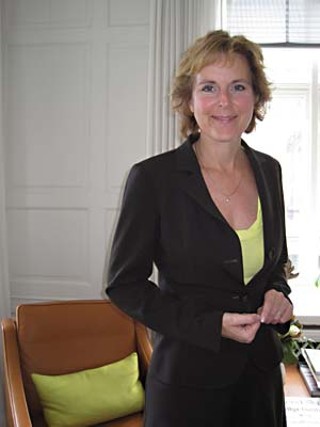
The more Copenhageners cycle, the safer it feels and becomes, and the more investments are made in the network of dedicated cycling paths. ... Every time new bike lanes and paths have opened, they have been resounding successes and quickly fill with people and bikes. The network now includes 350 kilometers of bike lanes, which has attracted more and more regular commuting and daily-use cyclists. ...
More fascinating facts about one of the world's most advanced cycling cities:
• Some 55% of permanent resident Copen-hageners bicycle to work. About 37% of everyone studying or working in Copenhagen (including those from suburbs, other cities, and immigrants) uses a bicycle; that puts about 150,000 cyclists on the road each morning. The city of Copenhagen has set a goal of increasing that to 50% by 2015. ... Compare that to Austin's goal: If memory serves, it's to increase our percentage of cycling commuters from 1% to 3%.
• On the major cycling routes (which have dedicated off-road bike lanes), more than 30,000 cyclists pass by daily. ... The most crowded lanes are now the bike lanes at rush hour – even on rainy or snowy days.
• Most Copenhageners say they cycle for transportation because it's the fastest, most efficient, and cheapest way to get around. ... Almost no one thinks of cycling as a political stance or a lifestyle statement – everyone cycles because it's practical, common, efficient, and safe. ...
• Green Cycle Routes: These separated "cyclist motorways" are broad, dedicated paths where riders have minimal contact with traffic. We rode on one during off-peak hours; we shared the paths not just with other cyclists but with joggers, skaters, mothers pushing baby carriages, and elderly people in motorized wheelchairs/scooters or tricycles.
Danish Minister Hedegaard on Obama
Friday, Oct. 9, 9:40amIn an interview this morning – following the announcement of President Barack Obama's Nobel Peace Prize – about negotiations toward an ambitious and binding global climate treaty at COP15, Danish Minister for Climate and Energy Connie Hedegaard said: "There's a new youth generation, all over the world, that through this presidency has a lot of hopes for the USA." "It's fantastic that a new generation of youths worldwide have this new hope. And it's a fantastic opportunity to reinvent U.S. leadership in the world," she said pointedly, "to take a leading position again, through a new generation of youth" who believe in Obama's message.
On the upcoming climate agreement, said Hedegaard: "What the rest of the world asks of the U.S. is just this: You must take your fair share of the responsibility. ... The biggest loser, if we don't get a common framework set, will be American business. It will be in the interests of American business to get an agreement. It's about economic and strategic and political leadership of the 21st century. That's what's at stake here – if the U.S. is going to be the leader of the world in the 21st century or not."
Got something to say on the subject? Send a letter to the editor.





